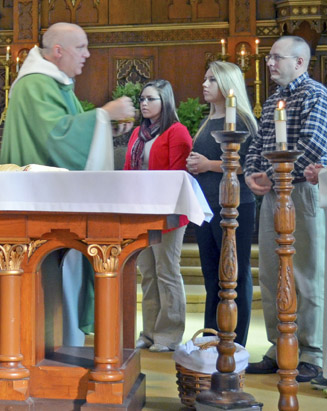By Corinne Winter

Editor’s note: On Dec. 4, 1963, Pope Paul VI promulgated the Constitution on the Sacred Liturgy, known in Latin as Sacrosanctum Concilium, the first document the world’s bishops approved during Vatican Council II (1962-65). To commemorate the 50th anniversary of Sacrosanctum Concilium, The Catholic Messenger is publishing a series of articles exploring key themes of the document. This article addresses ecclesiology.
In the statement that the Eucharist is the source and summit of the life of the Church, Sacrosanctum Concilium encapsulates the ecclesiology of the Second Vatican Council. The place of the document as the first to be promulgated by the council attests to the role that 19th and 20th century liturgical movements played in setting the agenda for the gathering of bishops. A key concern was that the laity should, by active participation in the liturgy, express and grow in our identity as full members of the Church whose presence and work is vital to its mission and to its identity. Celebrating Eucharist, we, the Church, declare and dedicate ourselves to be a holy people called by God for the sake of the whole world.
To describe ourselves as a holy people might seem a bit arrogant unless we recognize that the holiness we claim is not an achievement, but a gift and a challenge. The holiness comes not from anything we have done, but from God who calls us to share in the very communion that the Father, Son and Holy Spirit are, and to be a sign of that communion which all creation is called to share. It is also, therefore, a holiness that belongs not primarily to individuals, but to us in our unity.
Before the council, many of us had a tendency to think of holiness, as we did the liturgy, as something set apart, almost preserved from contact with the ordinary days and activities of our lives. Saints were people “up there” who somehow, even during their earthly lives had lived on a higher plane than most of us. Our celebrations of liturgy seemed to reflect that concept of holiness as distance from the ordinary.
Moreover, we understood the differences between the role of the laity and that of the priest as reflecting a hierarchy with respect to closeness to God. We viewed the Mass as something done in our name and for our sake by the priest whom we saw as above us in rank and often in holiness. We often spoke of our role as “hearing” Mass.
While the missal which contained the prayers in Latin and in English allowed us to follow along, we did not view our presence, much less our participation, as important to the action. Indeed, we sometimes used our time at Mass to go to confession or to pray individual devotional prayers. We would try to benefit others by offering our prayer at Mass for them or, especially after their death, by asking to have a Mass said for them, but we did not see ourselves as connected in the act of worship to those seated around us, let alone to the whole church. Sacrosanctum Concilium, the Council as a whole, and magisterial teaching since the Council have called us to view the liturgy as the act of the whole Church, the “work of the people,” as the etymology of the word liturgy suggests. The roles of lay liturgical ministers as well as our active participation in prayer and song are to express our vital membership in the worshipping community. Worshipping together we are and become “Church.”
As is the case with the holiness of the Church, its unity is first a divine gift. God calls us not as a collection of individuals but as a community. It is that call, the salvation offered in Christ, and the work of the Holy Spirit that make us one. After Vatican II, some of us in our enthusiasm could be caught up in a vision of the Church as a grand Kum-bay-ya whose unity could be accomplished by singing and swaying together and by giving the sign of peace as warmly and to as many people as possible. None of those are bad things, but they demonstrated a temptation to move from one extreme to another. From an overemphasis on the transcendent as though it ought to wipe out our daily lives, we could sometimes forget the transcendent dimension of life and of the Church. Vatican II calls us to view our ordinary lives as transformed by the constant presence of God. The Eucharist, in particular should keep us aware of that reality.
Finally, the ecclesiology to which the renewal of the liturgy calls us is an ecclesiology with a strong focus on the mission of the Church. In the liturgy, first and foremost in the Eucharist, we touch and are touched by the ultimate destiny we are called to share with the whole world. It is for the sake of that destiny, for the ultimate Reign of God that the Church and the liturgy exist.
(Corinne Winter is a professor of theology at St. Ambrose University in Davenport.)







